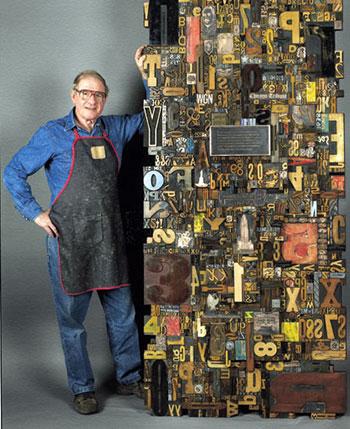By Lloyd Schermer ’50
Reviewed by E.G.B.
In the collections of, among other places, the Smithsonian American Art Museum and the Freedom Forum’s Newseum, both in Washington, D.C.
 |
Lloyd Schermer started collecting type in the mid-1960s, when he was a newspaper publisher in Missoula, Mont. His paper, the Missoulian, became one of the first to stop using hot metal type to print. With the switch to a faster, cheaper method known as offset lithography, the paper’s collection of type blocks became obsolete. Schermer hauled home a 40-drawer cabinet packed with the elegant, meticulously crafted type. He had no idea what to do with the letters, but he was sure of one thing: they were too beautiful for the dump.
Some 30 years later, Schermer retired as CEO of Lee Enterprises, which owns the Missoulian, and moved to Aspen, Colo. There he used the archaic type to turn a door in his house into a one-of-a-kind work of art. With that, Schermer began
a fruitful second career.
Today, he makes sculptures out of hundreds, sometimes thousands of pieces of antique wood and metal type and old engravings (see schermerart.com). To Schermer, each block is a work of art in itself. His sculptures are as many as six layers deep. “The pieces,” wrote the Aspen Times in 2006, “bring the viewer into a realm where symbols, how we use them, and the very act of communication can be examined.”
Among Schermer’s creations is a door for Washington Post CEO Donald Graham, as well as a wall sculpture for New York Times columnist Thomas L. Friedman. Schermer has also built twin pieces, two and a half feet deep and 25 feet long, for the conference room at The New York Times. Schermer’s “On Again, Off Again” (2006) is composed entirely out of ones and zeros, a tribute to computer binary code—and, in a way, to his time at Amherst, where he studied mathematical logic as a philosophy major.
“An American Puzzle” (2006) is Schermer’s gift to the Smithsonian American Art Museum in Washington, D.C. At four feet tall and eight feet long, the work combines hand-carved letters from the 1800s with engravings of cowboys, presidents and the Statue of Liberty. It is the only piece in the museum’s permanent collection that visitors are invited to touch. “When you stand back,” Schermer says, “it’s very abstract. When you get close, you see all these wonderful letters in different styles, formats, shapes and colors.”
At 80, Schermer recently completed a piece, built around a scale model of the Gutenberg press, for the lobby of the Freedom Forum’s Newseum, a Washington, D.C., museum dedicated to journalism. That sculpture spells out Gutenberg’s name in German Script foundry type.
Schermer, along with his wife, Betty, splits his time between Aspen and Tucson, Ariz. He is now trying to track down Cyrillic type in the former Soviet Union. (“Stalin shot anyone who had type in their personal possession,” Schermer says, “but a few did anyhow.”) The artist has accumulated what he suspects is the largest private collection of antique type in the United States, and perhaps in the world. “I’ve got enough to keep me going unless I live to 120,” he says. He then reveals that his mother died at 103. “So,” he says, “who knows?”